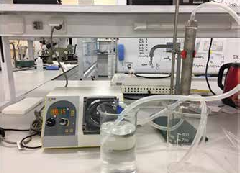- Home page /
- Technologies /
- Our publications about technologies /
- The Quantum PLT ® . Technology validation, lessons learned...
The Quantum PLT ® . Technology validation, lessons learned and perspectives
Kirill Ovchinnikov, Ksenia Saprykina, Pavel BUZIN, Andrey Guryanov, Alexander Katashov, GEOSPLIT LCC
 Drivers to use tracersfor production logging
Drivers to use tracersfor production logging
Drilling and completing horizontal wells is a key technical solution to improve hydrocarbon production. The objectives of production logging in horizontal wells are the following: to obtain data about petroleum reservoir, to evaluate its properties and to forecast the dynamics of hydrocarbon extraction. In this regard, the contribution of wellbore intervals to the total well production is an essential knowledge for operating companies. The main goal is enhancing hydrocarbon recovery. It is important to have an adequate well design and optimal location of fracturing well completiontools along the wellbore. A good well management engages the maximum length of a horizontal section into production. Today, most horizontal wells in Russia employ uncontrolled well completion equipment, and only 12% of wells are equipped with IDC (Inflow Control Device). Changes are expected in the future. By 2026, up to 50% of wells may be completed using ICDs [1]. ICDs allow to optimize well production and to deal with the breakthrough of water or gas. With the use of ICD, timely information on the performance of various intervals across wellbore becomes significant. In many cases, it takes time to organize conventional production logging with coiled tubing services. Also, the cost of standard production logging operation does not always correspond to the quality of obtained data. Few years ago, engineers of «Gazprom Neft» company did an interesting field experiment. They mobilized two wireline service providers for a repetitive PLT run into the same horizontal well [2]. The subsequent interpretation revealed difficulties with the convergence of the logging data. Indeed, the use of standard production logging downhole tools with single flowmetry spinner is not adequate for horizontal well and leads to interpretation errors. There is a need for an advanced downhole tool capable of dealing with the multi-phase and stratified flow [3, 4]. Wireline service companies offer PLT allowing spectral noise measurements. Those tools identify medium and high frequency anomalies associated with fluid filtration in cracks and pores of the collector. Joined implementation of acoustic sensors and thermometry, coupled with sophisticated software, improved the quality of downhole data. At the same time, the increasing complexity of production logging tools inevitably affects the cost of well intervention. The conventional downhole tools are designed to receive production data during well intervention only. Conventional PLT are unable to give a dynamic and extended in time downhole data. Thus, there is a strong market demand for more accessible production logging technologies to be used in horizontal wells. In this regard, tracer technologies can reinforce the portfolio of existing production logging technologies.
.....
Full version of the article can be downloaded here.
-
24.12.2021
Gazprom Neft, Skoltech and the Khanty-Mansi autonomous okrug-Yugra are developing technologies to produce hard-to-recover oil
-
17.12.2021
Gazprom neft establishes Russia’s first test facilities for developing hard-to-recover oil production technologies
-
25.11.2021
LUKOIL successfully tries out casing drilling
-
08.11.2021
Gazprom Neft and Gazprom Burenie to support the development of Russia’s first oil- and gas-well drilling robot

